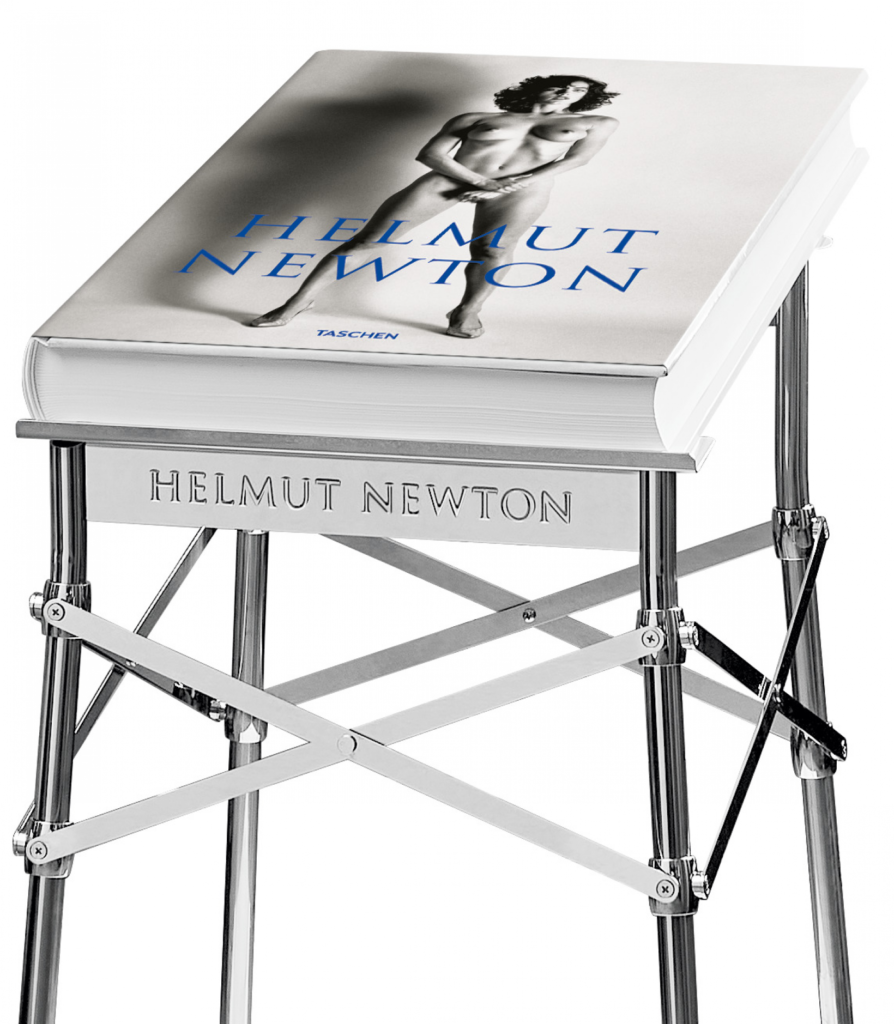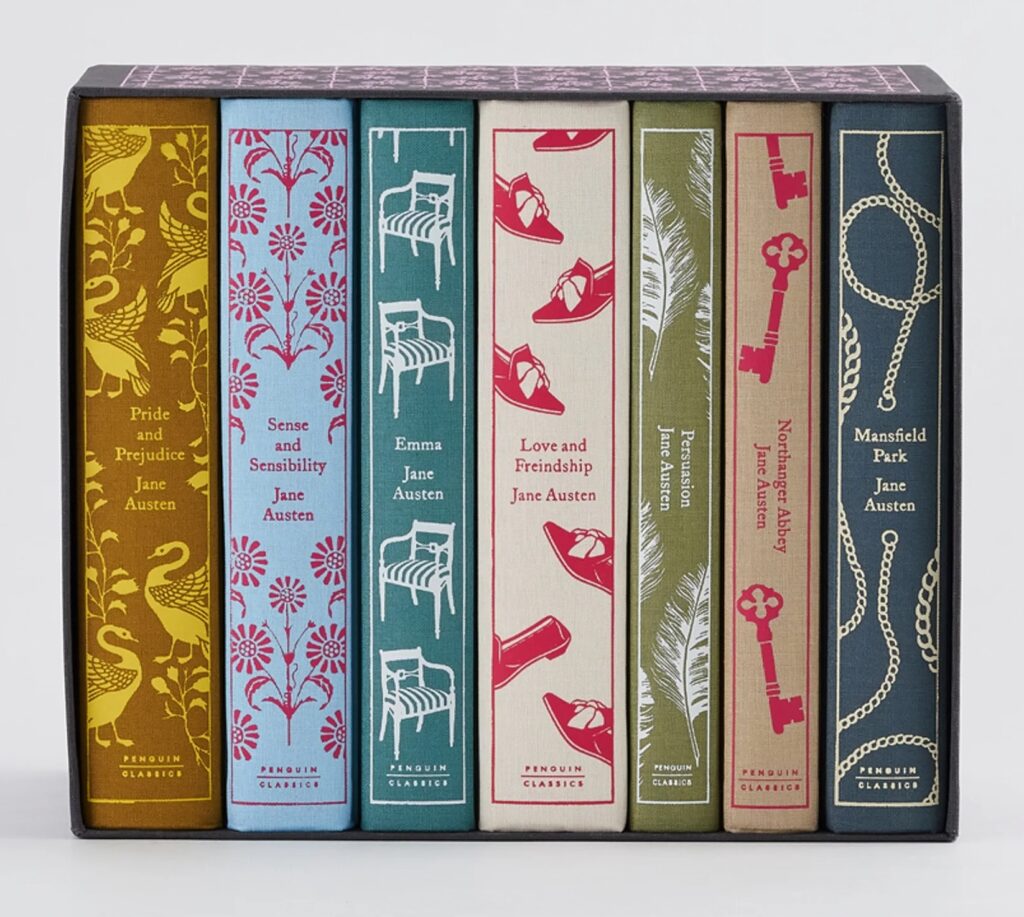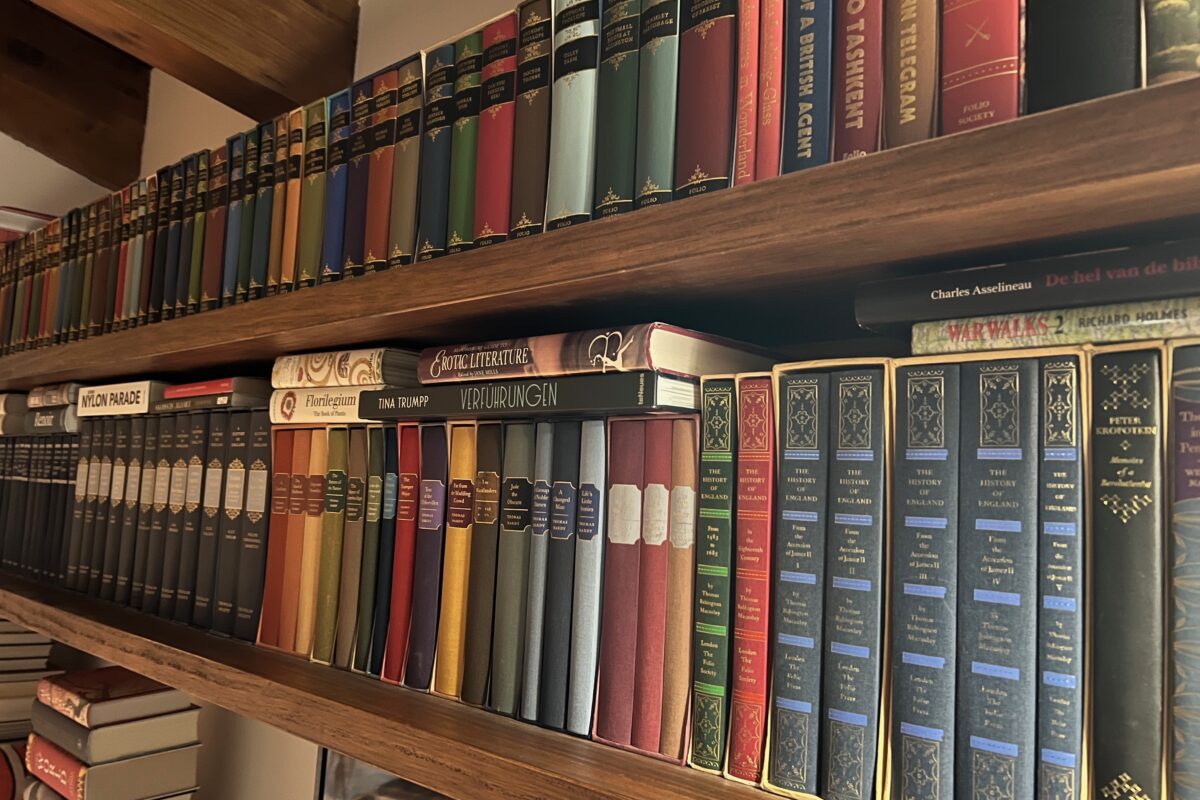The Luxury Book: An Antidote to Digital Fatigue
Luxury Living
In the ultimate revenge of the Comic Book Guy, Benedikt Taschen deserted the ranks of the German shop-keeping Mittelstand to become an accomplished publisher and a patron of contemporary art. Described by Vanity Fair as “one of the few people in business who has the courage to do exactly what he wants whenever he wants to,” Mr Taschen proved the point by publishing the world’s largest-ever book: a 464-page limited-edition of Sumo by the German-Australian photographer Helmut Newton (1920-2004), celebrated for his fetishist and subtly masochistic black-and-white shots which became a staple of Vogue and Harper’s Bazaar in the 1960s.
Measuring fifty by seventy centimetres and weighing slightly over thirty kilos, Sumo was provided with its own bespoke stand commissioned from French architect and designer Philippe Starck, a former artistic director at Pierre Cardin. Most coffee tables would probably not have supported the weight of a tome that redefined hefty. Sumo was released in 1999 in a 10,000-copy print run, numbered and signed by the photographer. The first book to roll off the press was autographed by all eighty artists featured in it, amongst them Nicolas Cage, Mickey Rourke, and Catherine Deneuve. A year later, that first copy fetched $430,000 at a Berlin auction – establishing a new record for a book published in the twentieth century.

Priced at $1,500 each, the first edition of Sumo sold out within weeks and firmly established the reputation of Taschen as a purveyor of luxury books. Whilst later – and much smaller – editions retailed at a more accessible $150, copies of the original are now trading at well over $18,000. A likewise Sumo-sized 2014 Taschen limited-edition of Annie Leibovitz’ photography featuring Patti Smith on the cover is also working its way up into the stratosphere with copies already trading at a fifty percent mark up over the original $2,000 retail price.
Underpinning its standing as a publisher of the outrageous, Taschen Books also released a $50,000 collector’s edition with work of Bulgarian installation artist Christo Javacheff and his Moroccan wife Jeanne-Claude, complete with an original lithograph and sketches. The company also published GOAT (Greatest of All Time), an 800-page biography of Muhammad Ali which recently saw its price double to $15,000. That amount does, however, include a statue of the fighter by New York sculptor Jeff Koons.
Beyond the Superlative
Though overstated in both size and price, Taschen Books looks positively run-of-the-mill when compared to Kraken Opus, a publisher set up in 2005 by retired Goldman Sachs investment banker Karl Fowler in Guernsey on the Channel Islands.

Mr Fowler is the publisher of the Burj Dubai Opus – an almost five-metre-tall book that graces the lobby of the landmark building. Scraping the sky at 829.8 metres, the 211-floor Burj Khalifa in downtown Dubai opened in 2010 after only six years of construction work. The giant book in its main lobby offers the definitive account of the building process and was commissioned by Emaar Properties, the Dubai-based developer that erected the world’s tallest free-standing structure. A more human-sized edition is now also being prepared, though at a price point as elevated as its topic.
Kraken Opus aims for the blatantly overstated – and makes no excuses for it. Publisher Karl Fowler is inspired by overachievers and considers it logical that their biographies should match their prowess. With projects financed mostly by anonymous Middle Eastern billionaire backers, Kraken Opus has published books such as the leather-bound Diego Maradona Opus, which ships with samples of the footballer’s hair, and the Prince Opus, complete with a branded iPhone. The publisher also secured an exclusive deal with the estate of Michael Jackson to release a luxury biography of the pop singer.
However, these books represent Kraken Opus’ low end. The publisher is mostly known for its extreme editions on sports teams and celebrities, snapped up by über-wealthy Middle Eastern monarchs and well-heeled members of their retinues, for a million dollars or more.
A copy of the Manchester United Opus recently changed hands for a cool $1.5m, establishing a new record as the most expensive sports book ever sold. In 2010, investors primed for the imminent release of a Kraken Opus biography of India’s cricket legend Sachin Tendulkar, widely considered the greatest batsman of all time, quickly bought up the entire ten-copy print run of the $75,000 book. In a rather bizarre twist, a pint of Mr Tendulkar’s blood was mixed in with the paper pulp to produce the signature page.
The resale market for highly exclusive books remains, however, difficult to gauge. Traditional auction houses such as Christie’s and Sotheby’s have so far declined to include them in their catalogues which, for now, remain the domain of rare manuscripts and century-old first editions. The venerable British auctioneer Bonhams of London’s New Bond Street, has offered a few modern over-the-top titles to mixed results.
The Comic Book Guy
Benedikt Taschen, who started his career as a seller of pre-loved US comics in Cologne, thinks it still far too early for a second-hand market of luxury books to appear. Whilst investors have thrown a few coins into the extravagant book niche, the segment is far too small to merit more, even when compared to other potentially lucrative market snippets such as rare coins and stamps. An added concern is the wearing thin of the novelty factor. None of the mega books place a premium on literary content. The work of their authors is but a footnote to the books’ presentation, size, and extravagant finish.

Taschen Books has wisely hedged its bets and used the publicity, and profits, generated by the firm’s limited-edition flagship titles to develop a full line of finely crafted yet accessible books at popular prices. The Taschen Basic Art series, started in 1985 and now comprising 95 volumes, proved a runaway success which was replicated with additional series on architecture, cinema, photography, and lifestyle. The publisher also opened a string of dedicated bookstores in European capitals and a number of US cities. The company maintains an art gallery in Los Angeles and is widely recognised as a standard bearer for the printed book, fiercely resisting the temptation to go digital.
Though forecast since the advent of the computer age, the paper book is staging a timid comeback. After years of steady decline, the number of brick-and-mortar bookshops in Amsterdam has been on the rise for the last three years and now stands at 134, excluding stores operated by retail chains. Though still a far cry from the city’s vibrant literary scene that sustained 312 bookshops in the mid-1970s, the rot has been halted. Similar trends have been detected in other European capitals.
Moving Upstream
Mass-market luxury publishing, not necessarily a contradiction in terms, contributes to the resilience of the paper book. In the UK, Penguin Books – the world’s largest publishing house and built on the now perhaps outdated premise that a good book should not cost more than a pack of cigarettes – regularly releases luxury clothbound editions of classic works of literature for as little as £14. With the price of a pack of smokes approaching the ten quid mark, the publisher has stayed remarkable true to its mission. Recently, Penguin published the complete works of Jane Austen as an exquisitely finished seven-volume boxed set for £65 – a remarkable feat attributed to the publisher’s pursuit of economies of scale.

Nestled by the far end of the size-to-scale model, The Folio Society – in business since 1947 and with a mission to publish ‘the world’s great literature in a format worthy of the contents’ – has established, and maintained, a formidable reputation for its finely crafted tomes. Folio editions are almost universally prized for their specially commissioned artwork, tasteful presentation (a tribute to the uniquely British sense for understatement), and meticulous attention to detail. Delivered in their signature slipcases, Folio Society books – all limited editions by their very nature – are made to last for centuries and usually hold their value well in the surprisingly large and lively secondary market.
Currently, the Folio Society published slightly over sixty new titles annually, including multi-volume sets. The society also maintains a backlist of some 450 titles. Editor Sue Bradbury, who retired from the company in 2011 after thirty years of plotting its course through literature, is credited with making the Folio Society into a household name and providing a solid structure to the publisher’s erstwhile rather haphazardly composed portfolio. However, an expansion into the US fuelled by generous giveaways to new members ran into trouble over cultural differences. The huge American market for luxury books is one that mostly prefers style and encyclopaedic uniformity over substance.
Imposing Looks
Whilst the Folio Society has long since moved away from the standardised design that marred its early years, US specialty publishers such as the Library of America, Easton Press, and (now defunct) Franklin Books stick to the tried-and-true formula of churning out similar looking tomes. All Easton Press books are leather-bound and feature 22kt gold lettering, raised spines, and gilded page edges. Whilst veritable treasures, Easton Press books lined up on a library shelf exude a severely daunting, and rather colourless and menacing, look emphasising the fact the most tomes have perhaps only merited a cursory glance from their owner. Whilst the Folio Society aims to deliver rapture, its American counterparts provide status symbols.
Interestingly, Easton Press editions rapidly lose their resale value and have even turned up in sizeable piles at landfills, just as National Geographic magazines are almost never discarded piecemeal by original owners or their descendants. Whilst craving most Folio Society editions, second-hand booksellers shun Easton Press tomes almost as much as they do books published by Time Life or Reader’s Digest.
Luxury books do, however, come at a price. The average price of a Folio Society edition hovers around £40 with boxed sets easily surpassing the £100 mark. Though nowhere near the prices commanded by Kraken Opus or Taschen Books’ specialty editions, their elevated cost limits the market for Folio Society books to committed bibliophiles who couldn’t bear to own major literary works in mere paperback editions. In a move to broaden its appeal, the publisher no longer limits sales to members and, in a dramatic break with tradition, has begun distributing books via select retailers such as Harrods and Waterstones.
Bibliophile Millionaire
Founded in 1947 by Charles Montague Ede, a WW2 tank commander who preferred the London School of Printing to Oxford University, the Folio Society flourished after Lord Gavron (1930-2015), a millionaire, philanthropist, and life-long Labour peer known for his support of the arts, took over the business in 1982 using part of the proceeds from the sale of his St Ives Printing Group – a business he transformed from a derelict outfit worth £5,000 into a £400 million international concern churning out close to a hundred million books annually. In the years following Lord Gavron’s arrival, Folio Society membership ballooned from around 20,000 to well over 150,000 which ensured the sale of at least 600,000 books annually under its (now ditched) membership scheme.
Recognised for his conservative approach to finances, Lord Gavron made his mark on history when he convinced Tony Blair in 1996 to moderate New Labour’s attitude towards the business community. In an interview with The Times, Lord Gavron remembered the two things he did after making his first million: buying a Rolls Royce and then selling it: “I realised that being rich meant you can do whatever you want. Then you may discover that what you want is quite modest and you’ll have to work out what to do with the rest of it.” Philanthropy, discreetly disbursed, provided the answer.

A good fit in the cultured atmosphere of the society, staff were delighted to find the new owner staggeringly well-read and with a taste for literary oddities matching theirs. Moving the Folio Society into premises that matched its highbrow reputation on Eagle Street, overlooking Red Lion Square, Lord Gavron put the business on a sound financial footing without undermining its civilised character. He famously failed to stop a reprint of Edward Gibbon’s massive 8-volume The History of the Decline and Fall of the Roman Empire (“History is, indeed, little more than the register of the crimes, follies, and misfortune of mankind”), cheerfully admitting that his opposition was entirely misguided since the lavishly illustrated tomes remain amongst the society’s bestsellers.
Decline and Fall Derailed
However, it ultimately proved impossible to maintain the momentum. Since attaining its peak in the early 1990s, the Folio Society saw its catalogue-based marketing model undermined, first by the advent of the Internet and then, unexpectedly, by the reaction of publishers to the appearance of the e-book. Suddenly producing better quality printed books became all-important. As the niche of beautiful books went mainstream, the Folio Society was no longer master of its once exclusive domain.
However, the society is fighting back. It established a close working relationship with The Guardian, a natural fit since Lord Gavron had chaired the newspaper’s board, and doubling down on quality with new titles whilst biding its time for digital fatigue to set in – as it inevitably must. A testament to its indomitable resolve, the society recently published a letterpress edition of Shakespeare’s plays printed in Germany by Haag-Drugulin, the same centuries-old firm that produced the first editions of Thomas Mann and Franz Kafka. The 36 exquisitely finished books in the series constitute a veritable celebration of traditional craftsmanship. Volumes retail at £295 each and the society reports, happily, that sales have been brisk. Quality, it would seem, never goes out of fashion.
Cover photo: Folio Society books in the author’s library.


